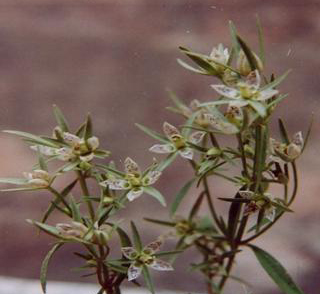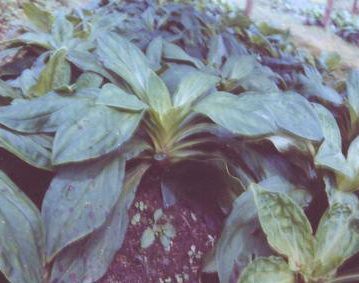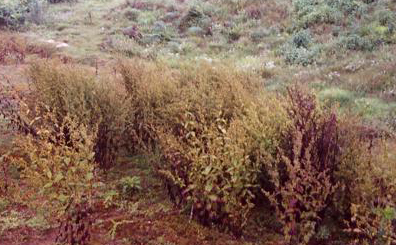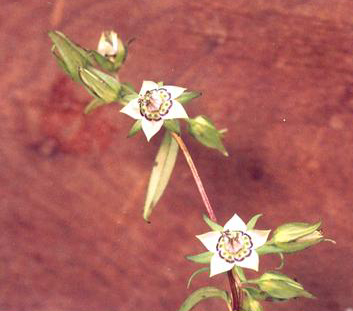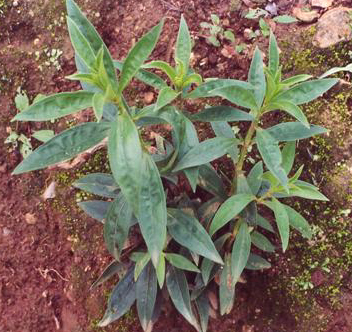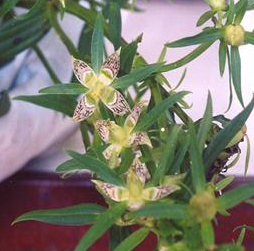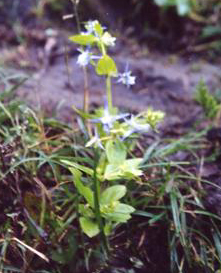SEARCH the
Gentian Research Network
and Rutgers University:
GENTIANS
Classification (newest)
List of genera
List by tribe
Gentian characteristics
Gentianales
RESEARCH
Research projects
People, addresses
Literature, publications
Links
Add info to
this site
TOPICS
Anatomy
Common names
Ecology - Natural history
GEOGRAPHY
Floras
Latin America
North America
TRIBES
Saccifolieae
_____________________
Information in other languages:
_____________________
This page
is maintained
by Dr.
Lena
Struwe
(e-mail),
and hosted by
Rutgers University, USA
updated: 01/19/11
| Swertia
in Nepalese Himalaya (Gentianaceae: Gentianeae: Swertiinae: Swertia) by Shankar Pant Swertia
images |
||||||||||||||||||||||||||||||||||||||||||||||||||||||||
|
Exploration of the local flora is yet to be done in many places in Nepal. There is still a high probability to come across new species of Swertia. The actual number of Swertia species in Nepal, thus, is a subject of uncertainty. A total of 29 species are so far reported from Nepal. Among them, Swertia graciliescens is endemic to Nepal.
Habitat:
Distribution:
Conservation status:
Domestication:
Trade:
Among these S. chirayita plays a dominant role in trade covering about 80% of total traded volume of Chiretta (Swertia spp.), and is superior in quality to other species. Most of the Chiretta (80-90%) are exported as a crude drug to India, occasionally to China, Malaysia, Singapore, Germany, Italy, France, Switzerland, Sri Lanka, Bangladesh, Pakistan, or USA. Nepal trades about 50 percent of the world’s total volume of Chiretta.
Trade of Chiretta (kg) in five
developmental regions of Nepal (in Kg)
Source: Hamro Ban (2001, 2002), Department of Forestry, HMG/Nepal.
Market Price: The market price of Chiretta bears a frequent fluctuation as seen in the comparison of current (NRs* 80-150/Kg) and previous prices (NRs 400/Kg, in 2000) *[1 US dollar= 74.64 Nepalese currency (NRs), 2004] Royalty Rate: NRs 3.00/Kg for entire plant (Forest Rules, 1995).
Economic importance of Swertia species (Chiretta)
Swertia species have broad spectrum Ayurvedic and Allopathic values. Of the 29 species of Swertia identified in Nepal, Swertia chirayita is powerful/effective non-toxic cure for various diseases. Its whole plant is used in crude form and to manufacture different Ayurvedic/Allopathic medicines. Several other species of Swertia are also used as substitute of S. chirayita, but considered as inferior in quality. Chiretta is used to cure bronchial asthma, cold cough, diabetes, urinary disorder, febrifuge, gastritis, gastric ulcer, inflammation, burning sensation, jaundice, leucorrhoea, obesity, skin diseases, wounds, hepatitis, typhoid fever, vomiting in pregnancy. Chiretta is appetizer, bitter tonic, anathematic and used in alcoholic preparation as bitter flavoring agent. It is used for treatment of cancer.
Genetic diversity in seven Swertia species of Nepal (M. Sc. Dissertation by S. R. Pant, supervised by H. P. Bimb)
We examined the genetic diversity of seven Swertia species, encompassing eastern, central and western regions of Nepal through morphology and isozyme analysis. The species under investigation were S. angustifolia, S. bimaculata, S. ciliata, S. dilatata, S. nervosa and S. species(?). Analysis of morphological data showed significant diversity between and within Swertia species. Four enzyme systems namely; Peroxidase (Prx), Malate dehydrogenase (Mdh), Acid phosphotase (Acp) and Esterase (Est) were chosen to assess the isozyme variability using horizontal starch gel electrophoresis. The enzyme systems revealed 13 putative loci and 41 phenotypes. The allele Prx-Sc in cathodal side was found common in all the populations (27). Mdh was identified as highly polymorphic that exhibited maximum number of phenotypes i.e. 12 (29.3%) followed by 11, 10 and 8 for Prx, Est and Acp respectively. Prx showed both anodal and cathodal electrophoretic mobility, unlike Mdh, Acp and Est, which showed anodal mobility. The result revealed low level of genetic variation that ranged from 0 to 14.5 per cent, which emphasizes their potential value for conservation. Minimum isozyme diversity was detected in Swertia chirayita and maximum in Swertia bimaculata. Therefore, we strongly recommend for the immediate need of appropriate conservation and management practices for S. chirayita which is under high pressure of commercial exploitation in Nepal.
Species descriptions
Swertia angustifolia
Buch.-Ham ex D. Don var.
angustifolia
Common names:
chiretta (English), chiraito, bhale chiraito (Nepali), khalu (Newari),
khupli (Rai), leketite (Doteli). Fruiting period: September to December Habitat: Open grass land. Places of collection: Nagarjun; 1820m. Chauvar; 1500 (Kathmandu). Nagarkot; 2200 m (Bhaktapur). Godawari, 1400m (Lalitpur). Deymandu; 2000m (Baitadi).
Swertia bimaculata (Sieb & Zucc.) C.B. Clarke Common names: chiretta (English), chiraito, bhale chiraito, (Nepali), simme (eastern Nepal), khalu (Newari), khupli (Rai). Morphology: An annual herb, 45–58 cm tall. Roots yellow fibrous. Stems erect, branched, quadrangular or subquadrangular, 0.25 cm in diameter. Internodes 4.15–5.65 cm long. Stems leaves sessile or short petiolate. Leaves broadly elliptic or ovate, 2.4-12 x 1-5 cm, acute, veins 3-5. Inflorescences panicles of cymes, spreading branches. Flowers 4–5(–6)-merous. Pedicels erect, 1.05–1.9 cm. Calyx 0.25–0.3 (0.4) x 0.1–0.15 cm, narrowly oblanceolate, base narrowed, margin slightly revolute. Corolla yellowish white with purple spots in their upper half, oblong to elliptic, 0.6-1cm x 0.3-0.5 cm, two yellow green nectaries in the middle, naked. Capsules narrowly ovoid, 0.7-0.9 cm in length. Seeds numerous, brown or reddish brown. Flowering period: July-November. Fruiting period: October–December. Habitat: Swamp, meadows. Places of collection: Lasune; 2400 m, Terhathum.
Swertia chirayita (Roxb. ex Fleming) Karstrn
Common names: chiretta (English), chiraito, pothi chiraito, (Nepali), khalu (Newari), khupli (Rai), lektite (Doteli), Kiratatikta (Sanskrit),Tenko (Gurung), Sungkhinwa (Limbu). Morphology: A biennial herb, 24-150cm tall. Roots yellowish. Stems cylindrical (dark bluish) below and quadrangular or terete upwards, 0.58 cm in diameter. Internodes 2.65–7.25 cm in length. Leaves opposite united at the base by transverse stipular line, sessile, large, ovate, elliptic, entire, acute, 5-nerved, 4.75–8 x 2.25-3.1 cm. Inflorescence a panicle, many-flowered, inflorescence leaves smaller. Pedicels 0.15–2.1 cm long, fascicled at the axis of inflorescence leaves. Flowers 4-merous. Calyx lobes 4, deeply partite, united at the base, linear or linear-lanceolate, 0.5- 0.6 cm long and 0.1–0.2 cm broad, smaller than corolla lobe. Corolla lobes 4, 0.3–0.4 cm long acuminate, two glandular depression at the base with long hairs. Stamens 4,opposite the corolla lobe. Capsules, globose, 2-valved. Seeds numerous, very small, dark brownish in colour. Flowering period: August to November Fruiting period: September to December Places of collections: Charikot; 2000 m (Dolkha). Nagarjun; 2100 m (Kathmandu). Dhulikhel; 1500 m (Kabhre). Kagate; 1800 m (Dhankuta). Kalika; 2150 m (Sankhuwasava). Panchpokhari to Basantpur; 2500 m (Terhathum).
Swertia ciliata (D.Don ex G. Don) B.L. Burtt.
Common names: chiretta (English), chiraito, bhale chiraito(Nepali), khalu (Newari), khupli (Rai), leketite (Doteli). Morphology: Annual, 20-51cm tall. Roots yellow, fibrous. Stems erect, sub-quadrangular, branched, 0.4 cm in diameter. Internodes 0.95–2.05 cm. Leaves sessile, opposite, lanceolate to ovate-lanceolate, 1.2–2.35 x 0.3–0.65 cm, apex acute, veins 3-5 cm. Inflorescences panicle of cymes, inflorescence leaves smaller. Pedicels arise in axils of inflorescence leaves. Pedicels 0.6–0.85 cm long. Flowers 5-merous. Calyx lobes 5, linear 0.2–0.3 cm in length. Corolla lobes 5, whitish, single gland at the base of each corolla lobe. Capsules 0.5– 0.6 cm long, ovoid. Seeds 2-3 in each capsule. Flowering period: September to November Fruiting period: October to December Habitat: Shady and moist places Places of collection: Panchpokhari, 3300m, Terhathum.
Swertia dilatata C.B. Clarke
Common names: chiretta (English), chiraito, bhale chiraito, sirlinge (Nepali), khalu (Newari), khupli (Rai), lektite (Doteli), Morphology: An annual herb, 15–72 cm in length. Roots yellow, fibrous. Stems erect, terete or 4-lineolate, 0.58 cm in diameter. Internodes 0.7–4.5 cm long. Leaves opposite united at the base by a transverse line, linear lanceolate, 1-3 nerved, ciliated at the base 1.35–5.75 x 0.25–0.6 cm. Inflorescences panicles. Pedicel 0.25–1.5 cm in length, fascicled at the axils of inflorescence leaves. Flowers 5-merous. Calyx lobes 5, deeply partite, elliptic, acute, 0.15 cm. Corolla lobes 5, purplish white, 0.5–0.6 x 0.2–0.3 cm, spreading horse-shoe shaped pit on each corolla lobe. Stamens 5. Seeds numerous. Flowering period: September–November. Fruiting period: November–December. Habitat: Open Meadows or partial shady place. Places of collection: Charikot; 2000 m (Dolkha). Nagarkot; 2250 m (Bhaktapur). Kalika; 2150 m (Sankhuwasava). Hille to Basantpur; 2200 m (Dhankuta).
Swertia nervosa (G.Don) C.B. Clarke
Common names: chiretta (English), chiraito, bhale chiraito (Nepali), khalu (Newari), khupli (Rai), lektite (Doteli). Morphology: An annual herb, 33–63 cm tall. Roots yellow–brown, fibrous. Stems quadrangular, narrowly winged on angles, branched, 0.35 cm in diameter. Internodes 1.5-3.9 cm. Leaves opposite, sessile or sub-sessile, elliptic or elliptic lanceolate, narrowed at the base, entire 1.7–5.3 x 0.45–1.5 cm, veins 1–3. Inflorescences panicles of cymes. Flowers 4-merous. Pedicels erect, 0.25–1.1 cm long. Calyx lobes 0.6–1 cm, linear lanceolate. Corolla lobes yellow-green, with purple stripes, 0.6–0.8 x 0.3–0.4 cm, ovate, oblong-acuminate, one large pocket-shaped gland with a scale in each corolla lobe near the base. Capsules ovoid, 0.7–0.8 cm. Seeds numerous, dark brown, ellipsoid. Flowering period: September–November. Fruiting period: November-December. Habitat: Shady and moist places. Places of collection: Hille; 1900 m (Dhankuta). Godawari; 1400 m (Lalitpur). Champadevi; 1850 m (Kathmandu). Nagarkot; 2250 m (Bhaktapur). Lasune; 2200 m (Terhathum). Basantapur; 2100 m (Terhathum). Bhagwati; 1800m, Chhapari; 1550 m, (Darchula). Deymandu; 2000 m (Baitadi).
Swertia species (?)
Common names: chiretta (English), chiraito, bhale chiraito (Nepali), khalu (Newari), khupli (Rai), leketite (Doteli). Morphology: An annual herb, 48-71 cm tall. Roots fibrous. Stems erect, 0.44 cm in diameter. Internodes 1.25–2 cm long. Leaves sessile, opposite, decussate, ovate-obtuse, 3–5-nerved. 3.6–4.6 x 1.2–1.8 cm, margin entire. Flowers bluish white, racemose, tetramerous. Calyx lobes 4, linear, slightly acute 0.5–0.6 cm. Corolla lobes 4, lanceolate with one round depression at the base. Flowering period: October-November Habitat: Shady and moist places. Places of collection: Panchphokhari, 2800 m, (Terhathum).
Contacts for this article:
Shankar Raj
Pant,
Research Assistant, Biotechnology Unit,
Nepal Agriculture Research Council,
P.O. Box: 1135, Lalitpur, Nepal Photo credits: M. R. Shrestha, S. K. Rai, & S. Pahari. See Swertia.
Note: The GENTIAN RESEARCH NETWORK does not endorse or encourage the use of gentians or gentian-derived products for any medicinal purposes or as a cure for specific diseases and ailments. The information is listed here for educational purposes only. The health value and safety of any of these plants and products has not been evaluated by us and we do not recommend any of them for medicinal use. © Shankar Pant, 2005 |
||||||||||||||||||||||||||||||||||||||||||||||||||||||||

